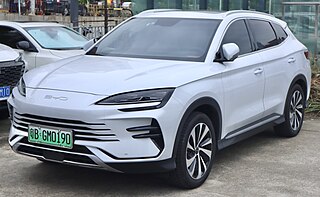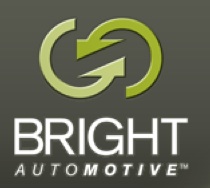
The automotive industry comprises a wide range of companies and organizations involved in the design, development, manufacturing, marketing, selling, repairing, and modification of motor vehicles. It is one of the world's largest industries by revenue.
Think Global was a Norwegian electric car manufacturer located in Bærum, which manufactured cars under the TH!NK brand. Production of the Think City was stopped in March 2011 and the company filed for bankruptcy on June 22, 2011, for the fourth time in 20 years. The company was bought soon after by Electric Mobility Solutions AS and production ceased in August 2012 with no more announcements regarding future production. As of October 2010, a total of 2,500 units had been manufactured at Oslo-based TH!NK's production facility.

Crude electric carriages were first invented in the late 1820s and 1830s. Practical, commercially available electric vehicles appeared during the 1890s. An electric vehicle held the vehicular land speed record until around 1900. In the early 20th century, the high cost, low top speed, and short-range of battery electric vehicles, compared to internal combustion engine vehicles, led to a worldwide decline in their use as private motor vehicles. Electric vehicles have continued to be used for loading and freight equipment and for public transport – especially rail vehicles.

A plug-in hybrid electric vehicle (PHEV) or simply plug-in hybrid is a type of hybrid electric vehicle equipped with a rechargeable battery pack that can be directly replenished via a charging cable plugged into an external electric power source, in addition to charging internally by its on-board internal combustion engine-powered generator. While PHEVs are predominantly passenger cars, there are also plug-in hybrid variants of sports cars, commercial vehicles, vans, utility trucks, buses, trains, motorcycles, mopeds, military vehicles and boats.

The FreedomCAR and Vehicle Technologies (FCVT) was a national Office of Energy Efficiency and Renewable Energy program developing more energy-efficient and environmentally-friendly highway transportation technologies to enable the United States to use less petroleum. Run by Michael Berube, it had long-term aims to develop "leap-frog" technologies to provide Americans with greater freedom of mobility and energy security, lower costs, and reduce environmental impacts.

An alternative fuel vehicle is a motor vehicle that runs on alternative fuel rather than traditional petroleum fuels. The term also refers to any technology powering an engine that does not solely involve petroleum. Because of a combination of factors, such as environmental and health concerns including climate change and air pollution, high oil-prices and the potential for peak oil, development of cleaner alternative fuels and advanced power systems for vehicles has become a high priority for many governments and vehicle manufacturers around the world.

A123 Systems, LLC, a subsidiary of the Chinese Wanxiang Group Holdings, is a developer and manufacturer of lithium iron phosphate batteries and energy storage systems.
United States Council for Automotive Research LLC (USCAR) is an umbrella organization for collaborative research that comprises Ford Motor Company, General Motors and Stellantis. Its goal is to further strengthen the technology base of the U.S. auto industry through cooperative research and development. It has Electrical Wiring Component Applications Partnership, United States Automotive Materials Partnership, and United States Advanced Battery Consortium (USABC) as part of its consortia. USABC pursues research and development of advanced energy systems for electric and hybrid electric vehicles to achieve significantly increased range and performance.

The history of plug-in hybrid electric vehicles (PHEVs) spans a little more than a century, but most of the significant commercial developments have taken place after 2002. The revival of interest in this automotive technology together with all-electric cars is due to advances in battery and power management technologies, and concerns about increasingly volatile oil prices and supply disruption, and also the need to reduce greenhouse gas emissions. Between 2003 and 2010 most PHEVs on the roads were conversions of production hybrid electric vehicles, and the most prominent PHEVs were aftermarket conversions of 2004 or later Toyota Prius, which have had plug-in charging and more lead–acid batteries added and their electric-only range extended.

Henrik Fisker is a Danish automotive designer and entrepreneur based in Los Angeles, California, US. He is best known for designing luxury cars. After working at BMW, Ford, and Aston Martin, Fisker founded Fisker Automotive in 2007. The company failed to meet production deadlines despite significant federal and private investment. Fisker resigned in 2013. The New York Times described the company as the "Solyndra of the electric car industry" and a "debacle". He is currently the CEO of Fisker Inc., which he co-founded with his wife in 2016.

Fisker Automotive was an American company. It produced the Fisker Karma, which was one of the world's first production luxury plug-in hybrid electric vehicles. The company was founded in 2007 by Henrik Fisker, a Danish automobile designer.

The Fisker Karma is a luxury plug-in range-extended electric sports sedan produced by Fisker Automotive between 2011 and 2012. The cars were manufactured at Valmet Automotive in Finland.

An electric car or electric vehicle (EV) is a passenger automobile that is propelled by an electric traction motor, using only energy stored in on-board batteries. Compared to conventional internal combustion engine (ICE) vehicles, electric cars are quieter, more responsive, have superior energy conversion efficiency and no exhaust emissions and lower overall vehicle emissions. The term "electric car" normally refers to plug-in electric vehicle, typically a battery electric vehicle (BEV), but broadly may also include plug-in hybrid electric vehicle (PHEV), range-extended electric vehicle (REEV) and fuel cell electric vehicle (FCEV).

Coda Automotive Inc. was a privately held American company headquartered in Los Angeles, California. The company designed and assembled lithium-iron phosphate (LiFePO4) battery systems for automotive and power storage utility applications, and electric cars. Miles Automotive partnered with Hafei and Qingyuan Electric Vehicle to establish Coda Automotive as an affiliate company. The name CODA comes from the musical term for the concluding passage of a piece of music. Coda Automotive has said that it chose the name because its electric vehicle technology represents an end for combustion engine vehicles, and the start of the electric vehicle era.

The adoption of plug-in electric vehicles in the United States is supported by the American federal government, and several states and local governments.

Bright Automotive was a startup company in Anderson, Indiana, working to create a fuel-efficient line of plug-in electric vehicles. The company was started in 2008 with a team of employees from former companies such as Chrysler, Delphi, GM, Mazda, and Toyota. The company designed its first vehicle, the IDEA, a plug-in hybrid electric fleet vehicle designed to reduce fuel costs for corporations that maintain a large commercial fleet. Bright also had a service branch called eSolutions that focused on speeding up the process of car electrification with consulting and conversions. Bright's last CEO, Reuben Munger, stated in early press releases that he wished to see the IDEA in production by 2013.

The Renault–Nissan–Mitsubishi Alliance, originally known as the Renault–Nissan Alliance, is a French-Japanese strategic alliance between the automobile manufacturers Renault, Nissan and Mitsubishi Motors, which together sell more than one in nine vehicles worldwide. Renault and Nissan are strategic partners since 1999 and have nearly 450,000 employees and control eight major brands: Renault, Nissan, Mitsubishi, Infiniti, Renault Korea, Dacia, Alpine, and Venucia. The car group sold 10.6 million vehicles worldwide in 2017, making it the leading light vehicle manufacturing group in the world. The Alliance adopted its current name in September 2017, one year after Nissan acquired a controlling interest in Mitsubishi and subsequently made Mitsubishi an equal partner in the Alliance.
Tesla, Inc., an electric vehicle manufacturer and clean energy company founded in San Carlos, California in 2003 by American entrepreneurs Martin Eberhard and Marc Tarpenning. The company is named after Serbian-American inventor Nikola Tesla. Tesla is the world's leading electric vehicle manufacturer, and, as of the end of 2021, Tesla's cumulative global vehicle sales totaled 2.3 million units.
Fisker Inc. is an American automotive company founded by Danish automotive designer Henrik Fisker and his wife Geeta Gupta-Fisker.

Redwood Materials, Inc. is an American company headquartered in Carson City, Nevada. The company aims to recycle lithium-ion batteries and produce battery materials for electromobility and electrical storage systems. Redwood Materials was reported to have a valuation of about $3.7 billion as of July 2021.
















